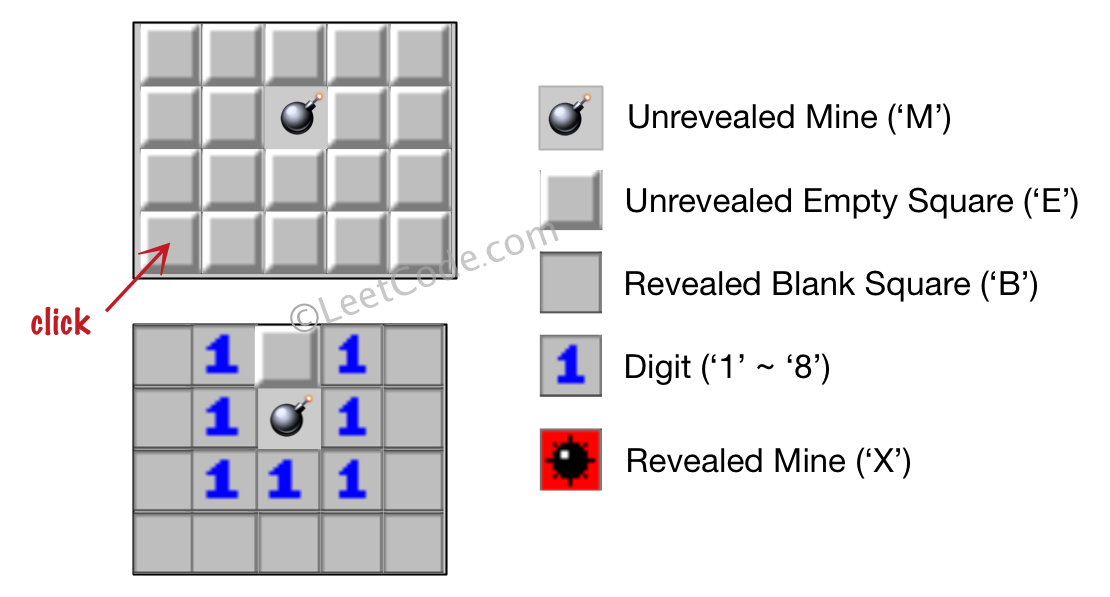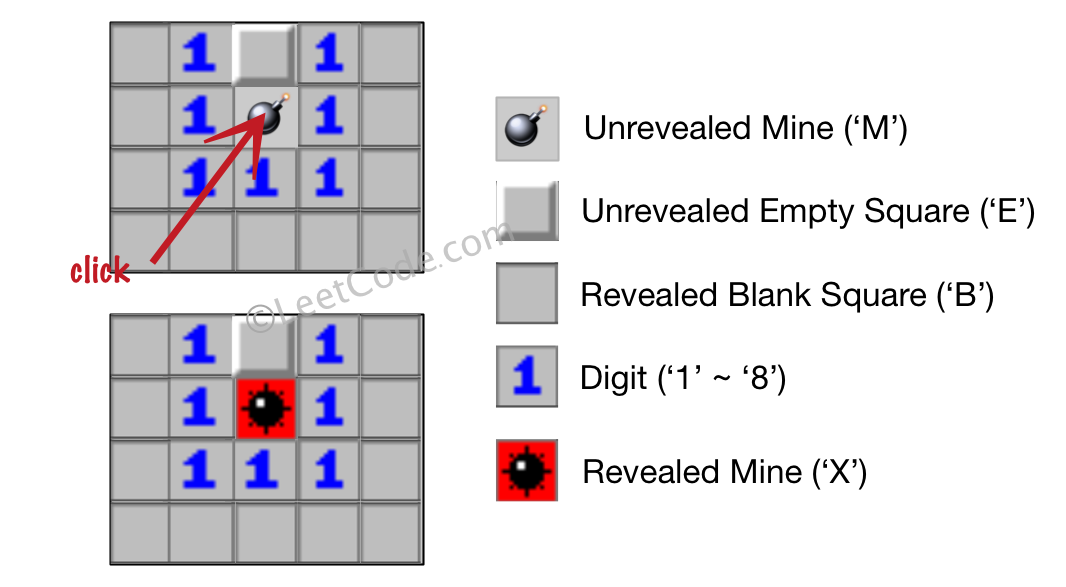LeetCode Minesweeper
Let’s play the minesweeper game (Wikipedia, online game)!
You are given a 2D char matrix representing the game board. ‘M’ represents an unrevealed mine, ‘E’ represents an unrevealed empty square, ‘B’ represents a revealed blank square that has no adjacent (above, below, left, right, and all 4 diagonals) mines, digit (‘1’ to ‘8’) represents how many mines are adjacent to this revealed square, and finally ‘X’ represents a revealed mine.
Now given the next click position (row and column indices) among all the unrevealed squares (‘M’ or ‘E’), return the board after revealing this position according to the following rules:
- If a mine (‘M’) is revealed, then the game is over – change it to ‘X’.
- If an empty square (‘E’) with no adjacent mines is revealed, then change it to revealed blank (‘B’) and all of its adjacent unrevealed squares should be revealed recursively.
- If an empty square (‘E’) with at least one adjacent mine is revealed, then change it to a digit (‘1’ to ‘8’) representing the number of adjacent mines.
- Return the board when no more squares will be revealed.
Example 1:
Input:
[['E', 'E', 'E', 'E', 'E'],
['E', 'E', 'M', 'E', 'E'],
['E', 'E', 'E', 'E', 'E'],
['E', 'E', 'E', 'E', 'E']]
Click : [3,0]
Output:
[['B', '1', 'E', '1', 'B'],
['B', '1', 'M', '1', 'B'],
['B', '1', '1', '1', 'B'],
['B', 'B', 'B', 'B', 'B']]
Explanation:

Example 2:
Input:
[['B', '1', 'E', '1', 'B'],
['B', '1', 'M', '1', 'B'],
['B', '1', '1', '1', 'B'],
['B', 'B', 'B', 'B', 'B']]
Click : [1,2]
Output:
[['B', '1', 'E', '1', 'B'],
['B', '1', 'X', '1', 'B'],
['B', '1', '1', '1', 'B'],
['B', 'B', 'B', 'B', 'B']]
Explanation:

Note:
- The range of the input matrix’s height and width is [1,50].
- The click position will only be an unrevealed square (‘M’ or ‘E’), which also means the input board contains at least one clickable square.
- The input board won’t be a stage when game is over (some mines have been revealed).
- For simplicity, not mentioned rules should be ignored in this problem. For example, you don’t need to reveal all the unrevealed mines when the game is over, consider any cases that you will win the game or flag any squares.
扫雷。给定一个棋盘和点击的坐标,要求给出点击之后新的棋盘布局。
为了做这个题,玩了一上午的扫雷。。。
更新规则很简单:
- 如果周围(上下左右和四个对角)没有雷,则该位置写’B’,并且递归的在周围模拟点击
- 如果周围有雷,则在该位置写上周围有雷的数目
- 如果点中了雷,则写上’X’,游戏结束
简单题,使用DFS,遇到以上第1条规则时,递归DFS。
代码如下:
[cpp]
class Solution {
private:
void dfs(vector<vector<char>>& board, int i, int j) {
if (board[i][j] == ‘E’) {
int m = board.size(), n = board[0].size();
vector<vector<int>> dirs = { { -1,0 },{ 1,0 },{ 0,-1 },{ 0,1 },{ -1,-1 },{ -1,1 },{ 1,-1 },{ 1,1 } };
int mines = 0;
for (int k = 0; k < dirs.size(); ++k) {
int x = i + dirs[k][0], y = j + dirs[k][1];
if (x >= 0 && x < m&&y >= 0 && y < n&&board[x][y] == ‘M’)++mines;
}
if (mines == 0) {
board[i][j] = ‘B’;
for (int k = 0; k < dirs.size(); ++k) {
int x = i + dirs[k][0], y = j + dirs[k][1];
if (x >= 0 && x < m&&y >= 0 && y < n)dfs(board, x, y);
}
}
else board[i][j] = ‘0’ + mines;
}
}
public:
vector<vector<char>> updateBoard(vector<vector<char>>& board, vector<int>& click) {
if (board[click[0]][click[1]] == ‘M’) {
board[click[0]][click[1]] = ‘X’;
return board;
}
dfs(board, click[0], click[1]);
return board;
}
};
[/cpp]
本代码提交AC,用时12MS。]]>


